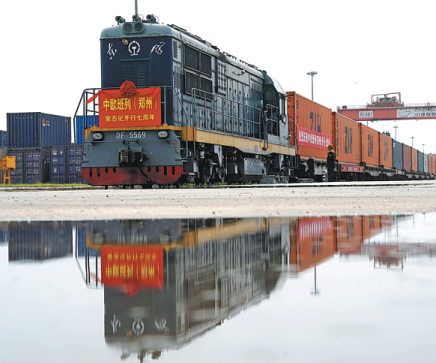Rail links put Sino-EU ties on fast track
Hiatus in air and sea transport offers sector chance to boost market share

While the COVID-19 pandemic has brought unprecedented disruptions to the world economy, it has led to the strengthening of rail links between China and Europe. And, say industry experts, the growing rail freight between East and West will help the economic recovery of the countries and regions involved in the Belt and Road Initiative.
The number of China-Europe freight trains surged significantly during the first half of this year, with a total of 5,122 trains being put into operation, up 36 percent year on year, according to the China State Railway Group.
Howard Rosen, the chairman of the not-for-profit Rail Working Group, said: "The growth has emphasized the need for fast and secure supply chains, and it has been part of a long-term trend driven by faster delivery times for goods going in both directions as well as a highly reliable service."
Carsten Pottharst, managing director of InterRail Europe, said: "In 2020, we just had a kind of a prolonged Chinese New Year. China restarted with a huge boost of Westbound traffic. One of the reasons is that railway companies were ready whereas long-distance trucking was difficult in China and also deep-sea capacity was reduced as ships were lying in the ports."
The freight trains have played an important role in helping with the global fight against the COVID-19 pandemic as a large quantity of medical supplies was transported by them to affected countries and regions, with anti-pandemic supplies totaling 3.67 million items and weighing 27,000 tons sent during the first 6 months of this year.
Experts said the disruptions in air and sea transportation as a result of COIVD-19 have presented an opportunity for rail freight to increase its market presence.
Barry Hembling, construction partner in London-based international law firm Watson Farley & Williams LLP, said: "Rail freight is an alternative to the quick but expensive option of sending goods by air, and the cheaper but longer option of using sea freight. While much of the increase will be linked to reduced opportunities to sending goods by air, the crisis is likely to increase opportunities for rail freight."
The China-Europe rail service was established in 2011 and is considered a significant part of the Belt and Road Initiative to boost trade between China and countries and regions participating in the initiative.
With rail freight traffic on the rise, China's top economic planner-the National Development and Reform Commission-recently allocated 200 million yuan ($28.3 million) to support the construction of transportation hubs in five cities to improve China-Europe rail freight services.
Commenting on the allocation, Rosen, of Rail Working Group, said: "Such investment is welcome and, without doubt, governments coming out of the crisis should now be looking at the way that they invest in transportation with a view to encouraging more environmentally-friendly forms of freight transport."
He pointed out that the economic recovery will depend on countries being able to ship manufactured goods and key components in both directions to support the revival of manufacturing in China and in Europe as their economies come out from lockdowns.
"As consumer demand revives, the manufacturing community will need to be able to respond to that demand quickly and cost effectively," Rosen added.
Call for more investment
The rail freight sector, in the short term, has survived relatively well despite the unprecedented economic downturn, in part aided by a reduction in passenger services that left the way clear for freight trains. But industry observers said that looking ahead, operators will need to be able to run longer freight trains with more efficient pathways.
"We will need more investment in the railways at a time when governments are very short of funds. It is essential therefore that governments give operators the tools they need to acquire the necessary locomotives and wagons and finance them cost effectively," Rosen said.
Rail cargo runs at double the speed of seaborne shipments, and at half the price of airfreight. Also, rail traffic creates just a 50th of the carbon emissions of planes.
Focusing on the emissions angle, Hembling said: "Given the increasing awareness of the climate emergency, (after the COVID-19 crisis) there is a real opportunity for rail freight to establish itself as an efficient and sustainable alternative to sending goods by air or sea."
Rosen echoed Hembling's view, saying: "In Europe, the focus on European freight corridors and the designation of 2021 as the European Year of Rail are clear markers demonstrating the determination of governments now to invest in green transportation."
While it is clear that globalization of trade will continue and the COVID-19 crisis has demonstrated how important supply chain management is to the international community, Rosen said: "Governments must seize this opportunity and create the conditions for an expansion of the rail sector and for movement of goods between Europe and Asia by rail."

Today's Top News
- China's industrial profits down 1.8% in H1
- Thailand responds to Trump's ceasefire call
- Recall vote shows DPP's manipulation runs against Taiwan people's will: mainland spokesperson
- Top DPRK leader visits China-DPRK Friendship Tower
- China proposes global cooperation body on AI
- Scholars propose inclusive human rights framework






























